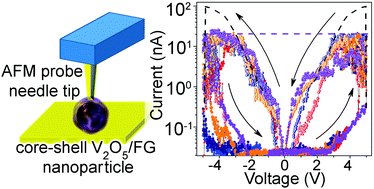Resistive switching on individual V2O5 nanoparticles encapsulated in fluorinated graphene films
Abstract
Memristors currently attract much attention as basic building blocks for future neuromorphic electronics. Due to their unusual electronic, optical, magnetic, electrochemical, and structural properties, transition metal oxides offer much potential in the development of memristors. Recent trends in the design and fabrication of electronic devices have led to miniaturization of their working elements, with nanometer-sized structures enjoying increasing demand. In the present study, we investigated resistive switching on individual vanadium oxide (V2O5) crystal-hydrate nanoparticles, 2 to 10 nm in size, encapsulated in fluorinated graphene (FG). Measurements using a conductive atomic force microscope (c-AFM) probe showed that the core–shell V2O5/FG nanoparticles make it possible to achieve bipolar resistive switching, reproducible during 104 switching cycles, with the ON/OFF current ratio reaching 103–105. The switching voltage of the structures depends on the thickness of the FG shells of the composite particles and equals ∼2–4 V. It is shown that the encapsulation of V2O5 particles in fluorinated graphene ensures a high stability of the resistive switching effect and, simultaneously, prevents the escape of water from the crystalline vanadium oxide hydrates. A qualitative model is proposed to describe the bipolar resistive switching effect in examined structures. Results reported in the present article will prove useful in creating bipolar nanoswitches.



 Please wait while we load your content...
Please wait while we load your content...